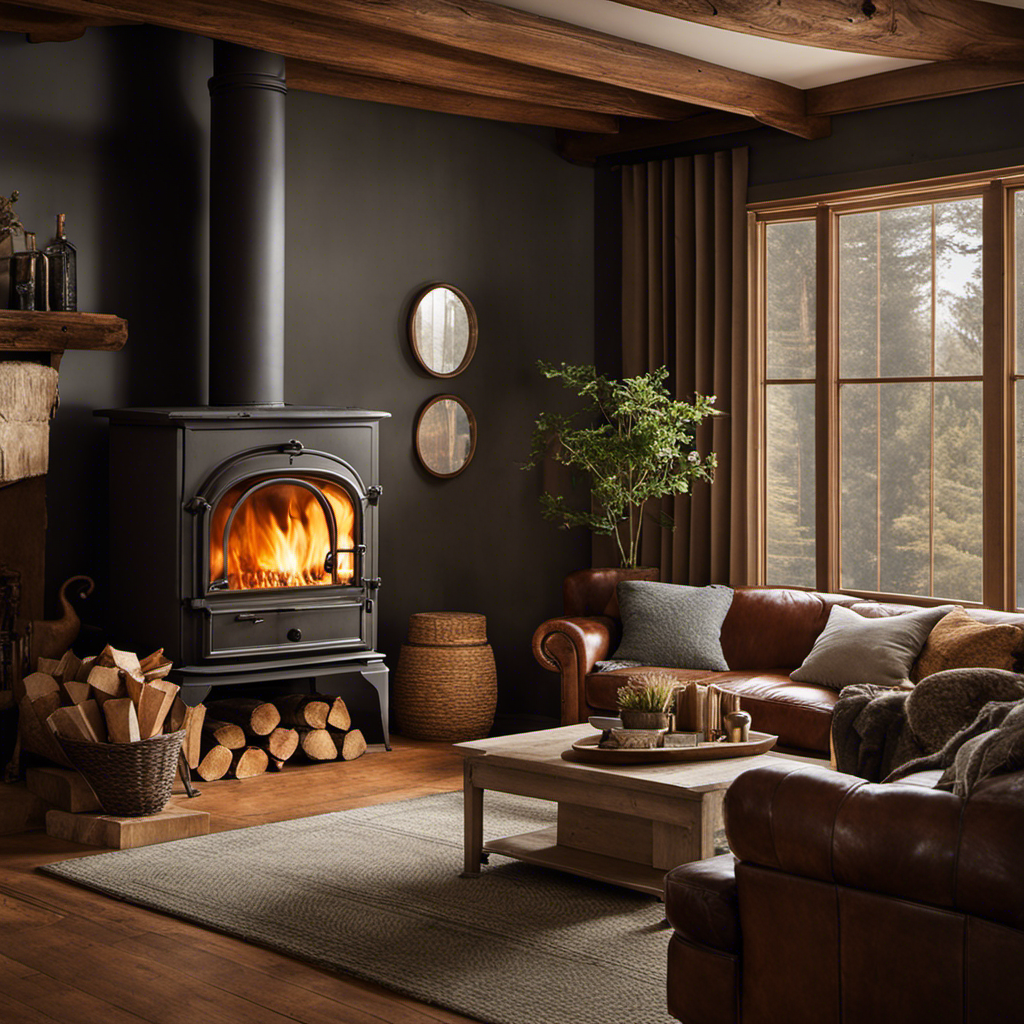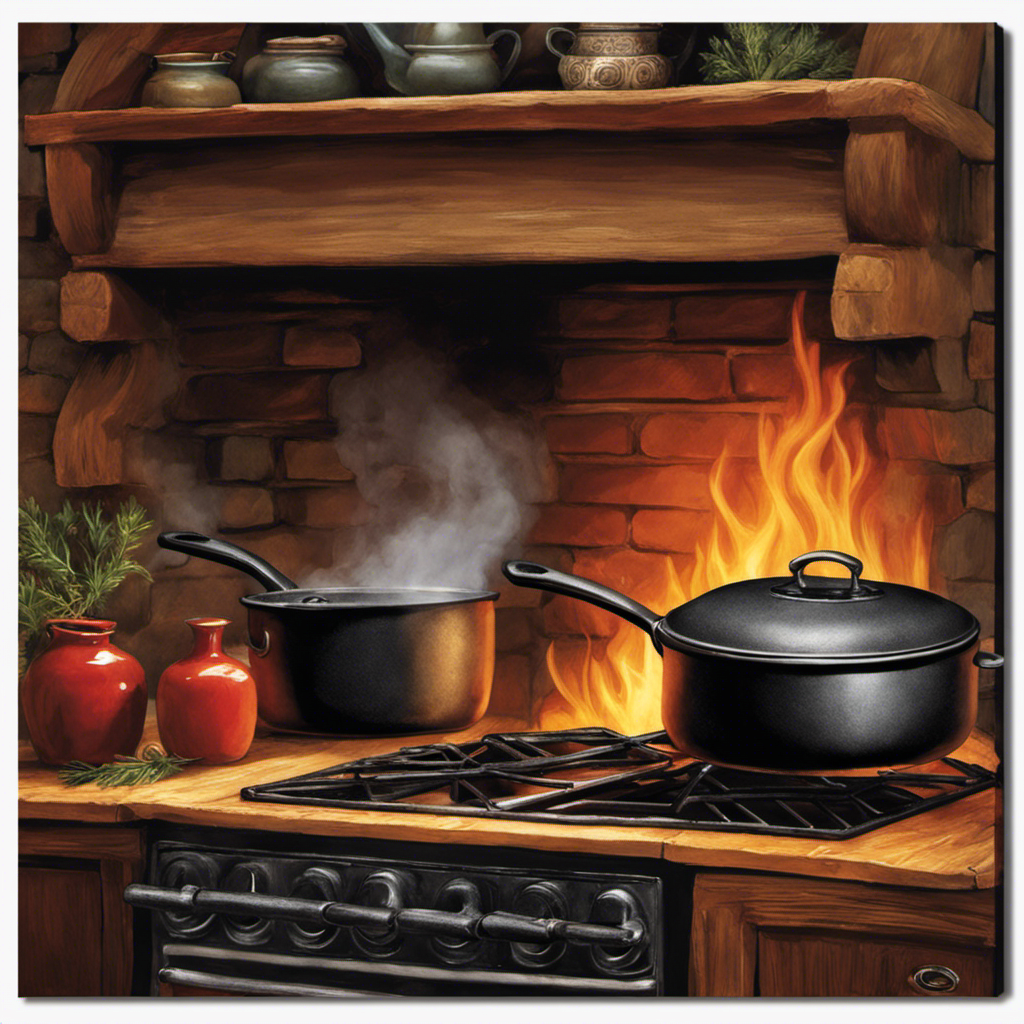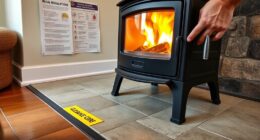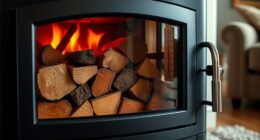Taming a wild fire when using an old wood stove can be a challenge. However, I have some helpful tips and tricks to ensure your home remains smoke-free.
Ventilate your stove area, choose the right wood, and maintain your stove regularly. Dry wood and properly seasoned firewood are key.
And don’t forget to control the airflow and burn efficiently. Follow my expert advice, and you’ll be enjoying the cozy warmth of your wood stove without the smoky hassle.
Key Takeaways
- Install a chimney damper and use a stove pipe thermometer to control airflow and prevent drafts.
- Select well-seasoned hardwoods with a moisture content of around 20% or less to burn for longer and produce less smoke.
- Regularly maintain and clean the wood stove, including professional chimney inspections and removal of creosote buildup.
- Use dry and properly seasoned firewood stored in a dry and well-ventilated area to ensure efficient burning and avoid excess smoke.
Properly Ventilate Your Wood Stove Area
I need to properly ventilate my wood stove area to prevent smoke buildup in my house.
One important step is to install a chimney damper. This device allows you to control the airflow, ensuring that smoke is properly exhausted outside. The damper should be opened before lighting the fire and closed when the stove isn’t in use to prevent drafts.
Another helpful tool is a stove pipe thermometer. This handy device measures the temperature of the exhaust gases, indicating if the stove is functioning efficiently. By monitoring the temperature, you can adjust the damper and airflow to optimize combustion and minimize smoke production.
Choose the Right Wood for Clean Burning
There are several types of wood that burn cleanly, such as hardwoods and softwoods, but it’s important to choose the right one for optimal combustion.
When it comes to choosing sustainable firewood, consider these key factors:
-
Moisture content: Select well-seasoned wood with a moisture content of around 20% or less. Wet wood produces more smoke and contributes to creosote buildup.
-
Density: Hardwoods like oak and maple are denser than softwoods, meaning they burn longer and produce more heat with less smoke.
-
Sustainability: Look for locally sourced firewood from sustainably managed forests to reduce your environmental impact and support responsible forestry practices.
Maintain and Clean Your Wood Stove Regularly
To maintain efficient and safe operation, it’s important to regularly clean and maintain your wood stove. Cleaning techniques are crucial in ensuring that your wood stove functions optimally and doesn’t pose any safety hazards.
One of the most common issues with wood stoves is the buildup of creosote, a flammable substance that can accumulate in the chimney and cause chimney fires. To prevent this, it’s recommended to have your chimney professionally inspected and cleaned at least once a year.
Additionally, cleaning the inside of your wood stove regularly is essential. Remove any ash and debris using a metal scoop or shovel, being careful not to damage the firebox.
Troubleshooting common issues such as a smoky fire or difficulty in lighting the stove can often be resolved by ensuring proper ventilation and using dry, seasoned wood.
Regular cleaning and maintenance are key to enjoying the efficient and safe operation of your wood stove.
Use Dry Wood and Properly Seasoned Firewood
Using wet or unseasoned firewood can result in poor combustion and a smoky fire. This can be avoided by ensuring the use of dry wood and properly seasoned firewood.
When it comes to firewood storage, it’s important to keep it in a dry and well-ventilated area. Moisture in the wood can lead to incomplete burning, creating excess smoke and harmful pollutants.
Properly seasoned firewood has a moisture content of around 20%, which allows for efficient and clean burning.
Regular wood stove maintenance is also crucial in preventing smoky fires. Cleaning the stove regularly, including the chimney and flue, ensures that the air flow isn’t obstructed and the fire can burn cleanly.
Control the Airflow and Burn Efficiently
While adjusting the damper, I can control the airflow and burn efficiently in my wood stove. This is crucial to maximize efficiency and reduce smoke production.
The damper is a small metal plate that regulates the amount of air entering the stove. By opening it fully, I allow more oxygen to reach the fire, resulting in a hotter and more complete combustion. This not only increases the stove’s efficiency but also reduces the amount of smoke produced.
On the other hand, closing the damper restricts airflow, leading to a slower burn and less heat output. It’s important to find the right balance to ensure efficient burning without excessive smoke.
Regularly monitoring and adjusting the damper throughout the burning process is key to achieving optimal performance from my wood stove.
Frequently Asked Questions
Can I Use Any Type of Wood in My Old Wood Stove?
I can use different types of wood in my old wood stove, but it’s important to choose seasoned wood. This ensures a cleaner burn and reduces the amount of smoke produced in the house.
How Often Should I Clean My Wood Stove?
I clean my wood stove at least once a month to ensure optimal performance. Regular cleaning prevents buildup of creosote and other debris, reducing the risk of a smoky house. Using seasoned hardwood is also important.
Can I Use Wet or Green Wood in My Old Wood Stove?
Using wet wood in my old wood stove has both pros and cons. Wet wood can create more smoke and reduce efficiency. To properly season wood for my stove, I ensure it is dry and well-seasoned.
How Can I Improve the Airflow in My Wood Stove?
To improve air circulation and reduce smoke when using an old wood stove, I suggest opening the damper fully, using dry seasoned wood, and ensuring proper placement of logs for optimal airflow.
Is It Safe to Leave My Wood Stove Unattended While It’s Burning?
No, it is not safe to leave a wood stove unattended while it’s burning. To prevent smoke from escaping, ensure proper ventilation, use dry and seasoned wood, and maintain a clean chimney.
Conclusion
In conclusion, by properly ventilating your wood stove area, choosing the right wood for clean burning, maintaining and cleaning your stove regularly, using dry and properly seasoned firewood, and controlling the airflow, you can use an old wood stove without making the house smoky.
Did you know that according to a study by the Environmental Protection Agency, using dry wood can reduce smoke emissions by up to 50%?
Implementing these tips won’t only keep your house smoke-free but also reduce your environmental impact.
Growing up surrounded by the vast beauty of nature, Sierra was always drawn to the call of the wild. While others sought the comfort of the familiar, she ventured out, embracing the unpredictable and finding stories in the heartbeat of nature.
At the epicenter of every remarkable venture lies a dynamic team—a fusion of diverse talents, visions, and passions. The essence of Best Small Wood Stoves is crafted and refined by such a trio: Sierra, Logan, and Terra. Their collective expertise has transformed the platform into a leading authority on small wood stoves, radiating warmth and knowledge in equal measure.











